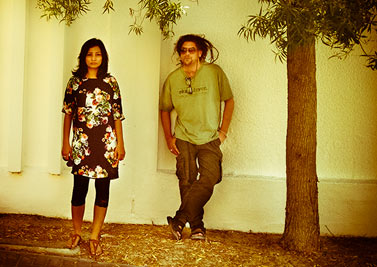There’s a continuous, all-pervading hum in Dubai. It’s a complex sound made up of industrial chundering, motor engines, water-pumps, and electric crackle. Dubai sounds restless, kind of like an unsleeping giant dogged by insomnia. On top of that, layer sporadic jangles of Hindi and Arabic pop, guffaws, and calls to prayer from minarets. Add engine-revving and mall muzak. Fireworks fizz. This is the sound of Ted Hughes’s Iron Man in a Lamborghini baseball cap, wearing a dishdasha, eyelids heavy, BlackBerry nearby. It’s under this mantle that Zahra Jewanjee and I made our first sound art piece, Vipralambha (Union Through Separation). Vipralambha is a soothing Sanskrit word (uncovered by Zahra) that conveys the sense of unrequited longing that is an exquisite pain. Zahra and I are artists living and working in Dubai. Zahra is from Lahore, I’m from London. Made from a collection of field sound recordings, Vipralambha is our antidote.
While in Lahore, Zahra had made some recordings at the tomb of Sufi Saint Baba Shah Jamal where, once a week, crowds come to watch devotees dance and drum themselves into trance-like states. She had also recorded a Lahore transvestite named Madam singing a popular song called “Shamma Pay Gaiya.” In its original form, “Shamma Pay Gaiya” is mere corny pop. However Madam’s own a capella version imbues the Punjabi lyrics with a true sense of the longing that is central to Vipralambha. For myself, I had spent some time in Kerala in South India, returning to Dubai with recordings of the announcer at the Alappuzha railway station, the Kathakali dance school in Fort Kochi, and crows during the monsoon in Kovalam, among others.
It is a delicious irony that Vipralambha is made from sounds originating in India and Pakistan, two countries who have a long tradition of mutual and often violent political and social friction. To us the piece is the antithesis to the urban sonic clamor of Dubai. But it’s also something else. Home to over ninety different nationalities and ethnicities, Dubai is underpinned by a large population of Pakistani and Indian workers. It’s this—largely male—workforce that does the jobs here that no one else will do, from construction work in blistering, forty-degree heat to sewage treatment, from street-sweeping to refuse collection. Often the workers live in spartan labor camps, three or four to a room, on the outskirts of the city. They’re bussed to their workplaces before the city is fully awake, and send spare money home to care for their wives and families at month’s end.
Vipralambha didn’t start life as a paean to the Indo-Pak workforce in Dubai. The stated aim of the piece was to meld sounds from two countries that share a border. However, it’s become a work with aims of its own. Aside from serving as a counterpoint to the sound of urban growth and conspicuous wealth, the piece acts as a tribute to the power of existence over adversity, and as an affirmation to the true meaning of human separation.
